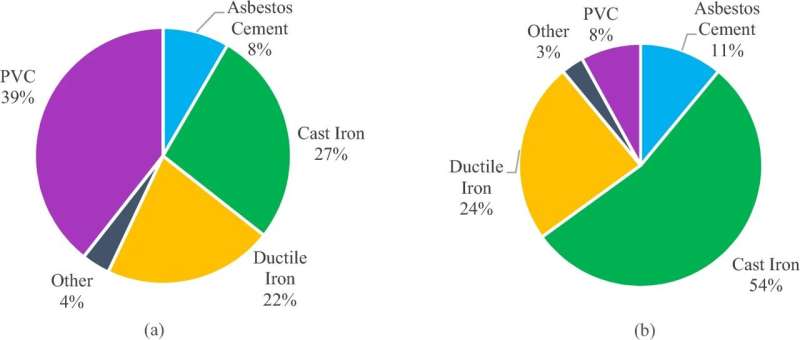This article has been reviewed according to Science X's editorial process and policies. Editors have highlighted the following attributes while ensuring the content's credibility:
fact-checked
trusted source
proofread
Water main breaks are rarely due to a single factor, research finds

Canadians are no strangers to water main breaks. Aging equipment, increased demand, seasonal weather changes, and many other factors have added stress to the infrastructure of utilities across Canada.
These challenges are not new, but the usual approach to studying them has often focused on pipe attributes and general protection strategies.
In a paper published in Environmental Systems Research, a pair of Concordia researchers looks at the problem from a global, systemic perspective by identifying the driving factors behind water main breaks across Canada. They hope their work will help utilities develop better models that can predict and, therefore, avoid potential breaks in the future.
Sadaf Gharaati, MSc 22, and Rebecca Dziedzic, an assistant professor in the Department of Building, Civil and Environmental Engineering, analyze data provided to them by 13 utilities in seven provinces, including inventories and histories of main breaks.
The data covers almost 26,000 kilometers worth of pipes and more than 62,000 water main failures. It also has information on pipe diameter, material, length, installation year, and failure year, among other variables.
"It is very rare to find a study that includes so many cities," Dziedzic says. "Having access to this kind of data allows us to see different perspectives and ways of collecting data, as well as each utility's different goals and results."
Fresh findings
After conducting a correlation analysis on the data provided by the utilities, the researchers found results that confirmed existing assumptions and revealed others that were not as well known.
Age, material, and diameter were the factors most associated with breaks. This was no surprise—the researchers say utilities are already aware of these correlations.
But less well-known were the effects of other variables, including pipe protection methods, such as types of lining or coating, joint types, soil types, and which types of breaks are more often found in which season: summer breaks are more often accidental, due to Canada's short but intense construction season, for instance.
Other findings included:
- Joints and fitting failures are most likely in pipes that are less than 20 years old. They are usually the result of poor installation rather than pipe quality.
- Universal joints were more likely to fail than collared ones.
- Pipes in clay and sandy soils are more likely to break than pipes in damper environments. Clay soil breaks are usually related to bedding issues, while those in sandy soil are linked to the way the structures settle.
"The utilities can use the data to implement better practices, such as improving communication with construction crews about the location and types of water mains in a particular area," Dziedzic explains.
"This research identifies the most important factors in water main breaks. And so, going forward, utilities can use this work to help them collect relevant data instead of going through huge amounts that contain information that may not be relevant to their failures," Gharaati adds.
"The hope is that we continue to work together with the utilities to create better predictions of future breaks," Dziedzic concludes. "This way, they can maintain and manage their systems better within their budgets. Hopefully, we will be able to create better models that look at more factors and can help reduce the potential of restricting people's access to clean water."
More information: Sadaf Gharaati et al, Analysis of factors driving water main breaks across 13 Canadian utilities, Environmental Systems Research (2024). DOI: 10.1186/s40068-024-00334-x


















